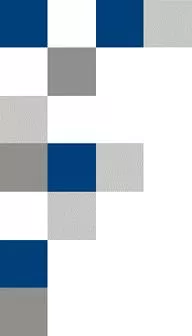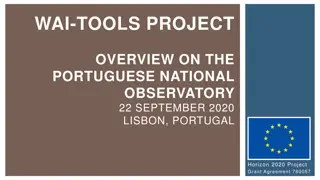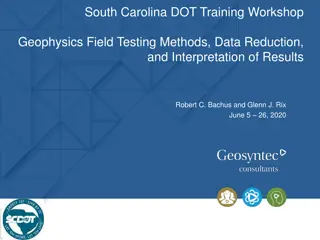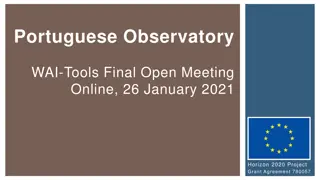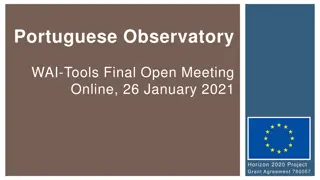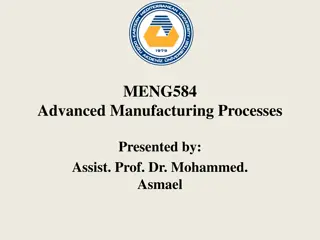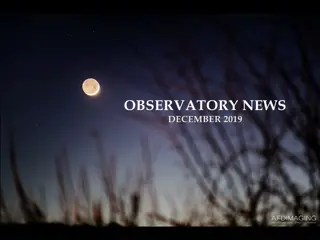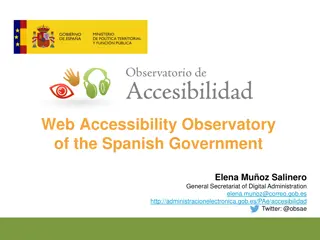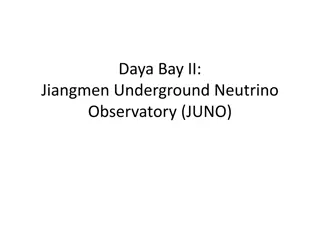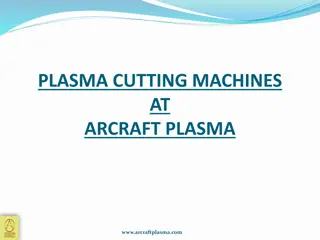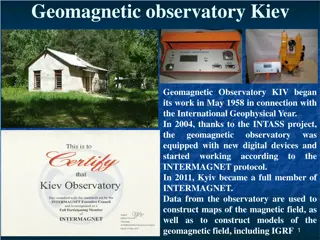Cutting-edge Technology at Sodankyl Geophysical Observatory
The Sodankyl Geophysical Observatory in Finland utilizes state-of-the-art technology for ionospheric research, including the Alpha-Wolf sounder, a sophisticated transmitter, and receiver array. The observatory has a rich history of ionosonde operations since 1957, with continuous advancements in data recording and resolution. The equipment used, such as FM chirp rate transmitters and advanced signal detection methods, ensures high-quality data collection for studying the ionosphere during solar minimum.
Uploaded on Sep 06, 2024 | 2 Views
Download Presentation

Please find below an Image/Link to download the presentation.
The content on the website is provided AS IS for your information and personal use only. It may not be sold, licensed, or shared on other websites without obtaining consent from the author. Download presentation by click this link. If you encounter any issues during the download, it is possible that the publisher has removed the file from their server.
E N D
Presentation Transcript
Auroral Ionosphere During Solar Minimum in Very High Time Resolution Th.Ulich1, T. Turunen1, E. Turunen*2 1Sodankyl Geophysical Observatory, Finland 2EISCAT Scientific Association, Sweden
The New Sodankyl Ionosonde Sodankyl Geophysical Observatory (SGO) replaced the previous ionospheric sounder by a new FMCHIRPCW sounder in November 2005. The new sounder has been designed and built in-house utilising exceptional solutions in many ways. We call it Alpha-Wolf because of the sound it makes when listening to the sweep by loudspeakers. It is the third ionosonde in more than 50 years since August 1957.
Sodankyl Ionosonde: IPY Operations August 1957-November 2005: half-hourly soundings, recorded on film. November 2005-March 2007: 10-min digital recordings, full raw data archived. April 2007-March 2008: 1-min digital recording, numerical ionograms every minute, raw data every 5 minutes. April 2008-today: we forgot to turn off IPY mode! Today we buffer 1-min raw data for at least 90 days so that special events can be archived in full resolution.
Transmitter and Modulation Frequency: 0.5 -16 MHz. Linear FM chirp rate is 0.5 MHz/s. Rhombic vertical transmitter aerials on 64-meter mast. Transmitter uses semiconductor amplifier modules. Power levels from 4 W to 100 W used. Sounding at one minute. GPS controlled DDS works at 40 bits accuracy level at 200 MHz clock rate. .
Receiver Array 20 orthogonal active loop antennas (N-S and E-W). phased array: 5 groups of 4 antennas. Area of array is 50x50 m2. Essentially flat response covering the sounding band and 12dB/octave roll off outside the band. The antenna array is located 930 metres from the transmitter antenna.
Example of an Antenna Group Note that trees have not been removed .
RF Filters and Signal Detection Alpha Wolf sounder uses complex quadrature detection of both received linear components directly to the baseband. GPS controlled frequency and time reference Identical frequency synthesisers in receivers and transmitter.
Post Detection Filters Analog 4-pole +10 kHz low pass filters and 5- pole own carrier suppression filters followed by very steep digital linear phase filter in AD- converters form the low frequency filtering. The resulting 3 dB bandwidth is +- 10 kHz, which limits the maximum range formally to 3000 km.
Analog to Digital Conversion Alpha-Wolf uses 24-bit audio AD-converters. Sampling frequency is 39062.5 Hz, Both linear received components are stored in complex format. The dynamic range of the conversion is so high, that it can handle the echo signal and interference under all conditions without any gain control or other adjustments.
The Receiver of the Alpha-Wolf Sounder The Alpha Wolf receiver and all the other components of the sounder have been designed and built in SGO. It has been a very reliable instrument.
Ionogram Computations All polarization control is done in the post processing during real-time ionogram computations. Numeric ionograms and 5-minute raw data are archived. 1-minute raw data is preserved for half a year in a circular buffer. The original raw data allows computation of ionograms using different, non-standard resolutions and better noise rejection if new and better filters are available.
Data Quality: Summer Summertime data is good as can be seen, e.g., from the monthly median curves of June 2008
Data Quality: Winter In winter time even continuous monthly median for foF2 is difficult. This is very common in winter especially during low solar activity. Almost every day has this well- known problem at high latitudes. .
Christmas Day 2008: An Example Christmas day 2008 is a typical winter day in high-latitude ionosonde data. One can doubt the night time data and the one who doubts is absolutely right. An example shows this. .
Ionogram 20081225-0200UT: the original version Here: A trace of sporadic E- layer (foEs 1.5 MHz), and perhaps a weak trace of an F-layer echo around 1.4 MHz plus a lot of interference. One cannot get anything more out from this ionogram.
Ionogram 20081225-0200UT: New Analysis Computation of the same data with a new program produces a different result.
Zooming in fmin is 0.5 MHz foF2 is just over 1 MHz foEs is around 1.4 MHz fbEs is about 0.7 MHz the peculiar F-layer echo around 1.4 MHz may be so called gyro echo, although proving it is almost impossible. Weak scatter is seen above foEs below 200 km virtual height.
A typical example, no echoes at all are seen on 20091209-0500UT
Ionogram 20091209-0500UT, new analysis => foF2=0.95 MHz .
The New Analysis for Ionograms Analysis strictly designed for computations needed to handle FMCHIRPCW soundings. Analysis software contains: Basic spectral estimate algorithms. Both auto and cross spectral estimates can be used. Filters for removing interference caused by broadcasting stations. Background estimate formation and subtraction. Filters for defining the main echo and scatter patterns. Numerous system testing possibilities.
Alpha-Wolf Sounder Performance Absorption is almost the only reason, which can prevent getting a usable ionogram. Interference is only very rarely a reason for disappearance of echoes. These cases occur mostly below 1MHz in winter night-time conditions. Even with the most demanding filtering selection the computations can be done in real time.
Summary Alpha-Wolf is a powerful ionosonde producing high quality data. Common problems exist during winter nights caused by high interference level. New analysis can to a large extent remove the interference problems. Original raw ionospheric data are archived every 5 minutes, 1-minute data available for at least 90 days. We plan to recompute the IPY data using the new analysis routines.


